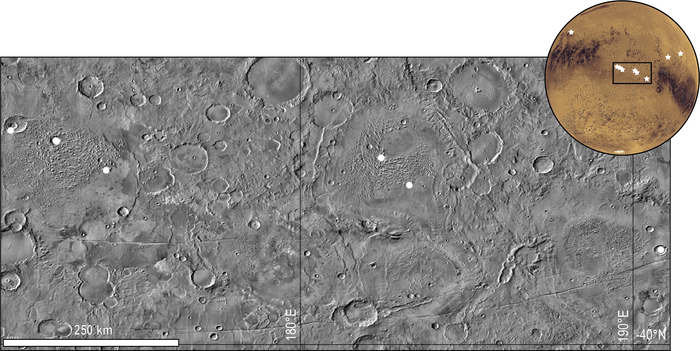Early crust on Mars may be more complex than previously thought—and it may even be similar to our own planet’s original crust.

Credit: Valerie Payré, University of Iowa
Early crust on Mars may be more complex than previously thought—and it may even be similar to our own planet’s original crust.
The Martian surface is uniformly basaltic, a product of billions of years of volcanism and flowing lava on the surface that eventually cooled. Because Mars did not undergo full-scale surface remodeling like the shifting of continents on Earth, scientists had thought Mars’ crustal history was a relatively simple tale.
But in a new study, researchers found locations in the Red Planet’s southern hemisphere with greater concentrations of silicon, a chemical element, than what would be expected in a purely basaltic setting. The silica concentration had been exposed by space rocks that slammed into Mars, excavating material that was embedded miles below the surface, and revealing a hidden past.
“There is more silica in the composition that makes the rocks not basalt, but what we call more evolved in composition,” says Valerie Payré, assistant professor in the Department of Earth and Environmental Sciences at the University of Iowa and the study’s corresponding author. “That tells us how the crust formed on Mars is definitely more complex than what we knew. So, it’s more about understanding that process, and especially what it means for how Earth’s crust first formed.”
Scientists believe Mars formed about 4.5 billion years ago. Exactly how the Red Planet came into being is a mystery, but there are theories. One idea is that Mars formed via a titanic collision of rocks in space that, with its intense heat, spawned an entirely liquefied state, also known as a magma ocean. The magma ocean gradually cooled, the theory goes, yielding a crust, like a layer of skin, that would be singularly basaltic.
Another theory is that the magma ocean was not all-encompassing, and that parts of the first crust on Mars had a different origin, one that would show silica concentrations different from basaltic.
Payré and her research partners analyzed data gathered by the Mars Reconnaissance Orbiter for the planet’s southern hemisphere, which previous research had indicated was the oldest region. The researchers found nine locations—such as craters and fractures in the terrain—that were rich in feldspar, a mineral associated with lava flows that are more silicic than basaltic.
“This was the first clue,” Payré says. “It is because the terrains are feldspar-rich that we explored the silica concentrations there.”
Feldspar had been found previously in other regions on Mars, but further analysis showed the chemical composition in those areas was more basaltic. That did not deter the researchers, who turned to another instrument, called THEMIS, which can detect silica concentrations through infrared wavelength reflections from the Martian surface. With data from THEMIS, the team determined the terrain at their chosen locations was more silicic than basaltic.
Adding further credence to their observations, meteorites such as Erg Chech 002, discovered in the Sahara and dating roughly to the birth of the solar system, show similar silicic and other mineral compositions that the team observed in the nine locations on Mars.
The researchers also dated the crust to about 4.2 billion years, which would make it the oldest crust found on Mars to date.
Payré says she was mildly surprised at the discovery.
“There have been rovers on the surface that have observed rocks that were more silicic than basaltic,” she says. “So, there were ideas that the crust could be more silicic. But we never knew, and we still don’t know, how the early crust was formed, or how old it is, so it’s kind of a mystery still.”
While Mars’ crustal origin remains shrouded, Earth’s crustal history is even less clear, as any vestiges of our planet’s original crust have been long erased due to the shifting of continental plates for billions of years. Still, the finding may offer insights into Earth’s origins.
“We don’t know our planet’s crust from the beginning; we don’t even know when life first appeared,” Payré says. “Many think the two could be related. So, understanding what the crust was like a long time ago could help us understand the whole evolution of our planet.”
Payré conducted the research as a postdoctoral researcher at Northern Arizona University. She joined the UI in August.
The study, “An evolved early crust exposed on Mars revealed through spectroscopy,” was published online Nov. 4 in the journal Geophysical Research Letters.
Contributing authors are Mark Salvatore and Christopher Edwards from Northern Arizona.
NASA funded the research, through the Mars Science Laboratory Participating Scientist Program and the Mars Odyssey THEMIS project.
Journal
Geophysical Research Letters
Method of Research
Observational study
Subject of Research
Not applicable
Article Title
An evolved early crust exposed on Mars revealed through spectroscopy
Article Publication Date
4-Nov-2022
COI Statement
There is no conflict of interest with the research.




